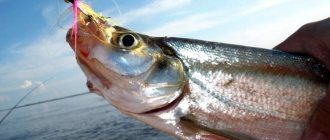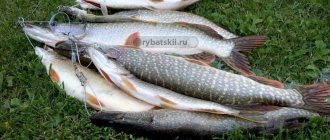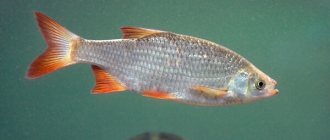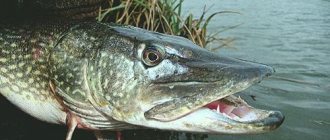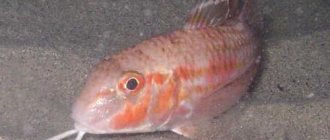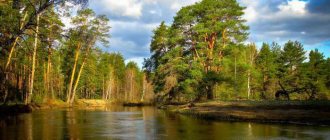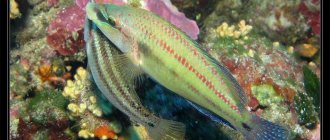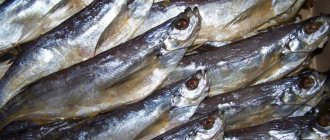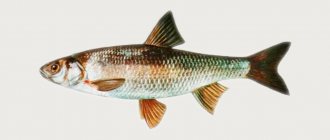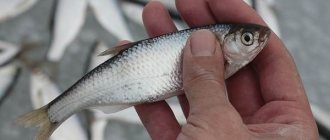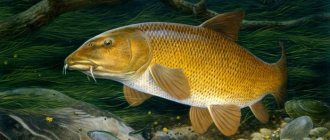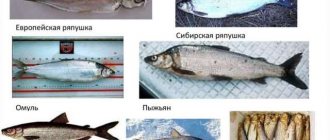Both beginners and experienced fishermen are well familiar with the types of bait used to catch fish, such as worms, maggots, and bloodworms. For some winter fishing enthusiasts, bait of animal origin such as jigs is something new and unusual. Therefore, not all fishermen know how to properly use amphipods when fishing, get and catch them, cook them, and also how to place gammarus on a hook while fishing.
Mormysh is an excellent bait, which is mainly used by float anglers and mainly in winter. In addition, it can be actively used in the form of bait or as an additional additive that can be used in the preparation of certain types of bait.
Crustacean - amphipod
Gammarus - who are they?
Few people know that the name of this inhabitant is “sand sea flea.” Bites from a small crustacean creature can not only cause pain, but also completely ruin your entire vacation.
In the scientific world, fleas living in sea sand are called gammarus. Few people know about their existence, and even if they have such an idea, they are of the erroneous opinion, thinking that the habitat of the small bloodsucking creatures is located somewhere on the far southern shores. This opinion does not coincide with reality. The sandy beaches of the middle zone have become almost native to gammarus, and not a single vacationer is immune from the possibility of getting bitten by them.
People who permanently live in close proximity to the sea coast know about the existence of parasites from the Talitridae family, calling them beach fleas. But vacationers, and even those who have come from afar, are unlikely to realize that the sand under their feet and the algae are simply teeming with these creatures.
How to get amphipods
People living in the city, as a rule, buy gammarus in specialized stores (such bait is usually called gammarus fish food). In addition, you can purchase such bait in online stores; place an order online.
However, there are several different ways that allow you to quite successfully catch crustaceans on your own in nearby bodies of water. At the same time, it should be noted that fish bite much more readily on jigs taken from the reservoir where fishing is planned.
Extraction of crustaceans using the “industrial” winter method
This method involves “scraping” gammarus directly from the bottom of the ice. For this, a special scraper is used, which is made from a box lined with fine mesh. There is a brush on one side of the scraper, and a long pole is attached to the other.
To catch a crustacean, the scraper must be lowered into the hole, and then carried out, leaning it with a brush against the surface of the ice, under water. Thus, after each wiring, crustaceans that were previously sitting on the underwater ice edge will fall into the scraper.
Using straw in flour
When extracting gammarus, you can use a sheaf of straw with flour sprinkled on it. Such a sheaf should be placed at the bottom of the reservoir and periodically (once every 24 hours) checked for the presence of crustaceans. This method allows you to catch not only mormysh, but also caddisfly, which is a very catchy bait, adored by almost all fish.
Using a trap
You can also use a special trap to catch amphipods. A fine net or rare fabric or tulle is perfect for making it. Place a small piece of bread in a cloth or mesh and wrap it. Then you need to attach a small weight to the trap and place it on the bottom of the reservoir.
After immersion in water, the crustaceans will begin to actively crawl into the package, from which they can be easily removed.
How to get mormysh in winter - visual video:
Description of appearance
Representatives of Gammarus are not so easy to see. Having dimensions of about 1 mm, parasites are capable of making long jumps of up to 30-40 mm. Fleas can perform such acrobatic feats thanks to their long legs, since they do not have wings. But the length of the jump is forty times greater than the size of the tiny crustacean body.
If you look closely, you can see the resemblance between fleas and shrimp. They are dark brown in color, and the body is divided into segments. The main difference between shrimp and gammarus is size. Sea fleas are much smaller than their relatives. It is believed that the parasites belong to the family of common fleas that live in the fur of cats and dogs.
The coastal sand of African and Indian beaches is filled with these inhabitants. They are found in Thailand, Vietnam and the Caribbean. Discarded seaweed scattered along shorelines is a favorite habitat for flea colonies. Hiding from sunlight, crustaceans find shelter and food in algae.
By the way, large accumulations of amphibiotic crustaceans, swarming in the sand, emit quiet howling sounds, upon hearing which it is better to move away from the surf line.
Before nightfall, amphipods burrow into deep layers of sand, but literally with the advent of moonlight they become more active. And during sunrise they crawl to the surface.
Laboratory studies have shown that the described creatures are able to tolerate temperature fluctuations from 0 to +25 degrees. But digging out of the sand is fraught with death for them.
Where do amphipods live?
Amphipods are widespread. Some species of multi-legged crayfish live in the seas. There are species of parasitic crayfish called whale lice.
They gather in huge groups on whales and eat their skin. They often cause deep ulcers. Whale lice, unlike other parasitic crustaceans, do not have free-swimming stages. Parasites pass from one whale to another during mating, and they are transmitted to the calves from mothers with milk.
Amphipods are very small in size.
In fresh waters, there are significantly fewer amphipod species. Only on Baikal there is a wealth of species; about 240 species of crustaceans live there, and they are found only in this lake. Amphipod crustaceans are not adapted to land.
Often these crustaceans lie on their sides, on the sand next to the water. Sometimes they form a thick, moving layer, and individuals sometimes jump out of the crowd. When a person or large animal approaches, the crustaceans begin to jump like fleas, pushing off the sand with their legs and abdomen.
During the daytime, sea fleas hide under stones or under algae lying on the shore, and at night they quickly move along the beach and look for dead algae, which they eat. Amphipods breathe through gills, so they can only live in a humid environment. On the Commander Islands, they spend the winter high above sea level, under the snow, hibernating.
Amphipods lead a parasitic lifestyle.
The danger of sea flea bites
The sea flea is capable of biting humans. As a rule, this can occur in places where there is a concentration of such crustaceans. When they drink blood, they leave bite marks accompanied by itching. We can firmly say that gammarus is not so harmless to humans.
The photo presented in the article will help to examine its mouthparts, which are capable of piercing the skin of the victim. By inflicting a bite, the female penetrates the skin and feeds on the blood she needs for the maturation of her future offspring. Thanks to this, its size increases to the volume of a ripe pea, and after the eggs ripen, the flea shoots them out and dies, leaving its remains in the victim’s skin. They are the ones that cause suppuration and pain.
In medical terminology, inflamed wounds after a flea bite are called sarcopsillosis or tungiasis.
Consequences of a bite
If you are careless about damage to the skin by crustaceans, scratch it and do not take any measures, the consequences can be disastrous. In medical practice, there are cases where a sea flea, having bitten a person, provoked the formation of sepsis, which resulted in the amputation of the toes.
The most accessible places to be affected are the lower limbs, buttocks, groin area, the space between the fingers, and the lower parts of the ankles.
It is important to remember that when you come to the beach, you should not sit in places where the sand under your feet is covered with algae - a favorite habitat for crustaceans.
Order Isopoda
Isopods have a body flattened in the dorso-ventral direction. Carapace is missing. There are sessile compound eyes on the head. The thoracic region consists of 6–7 segments. The thoracic legs are single-branched, walking, having the same structure (hence the name of the order). The abdominal legs are bibranched, leaf-shaped, and perform a respiratory function.
Woodlice are crustaceans that have adapted to a terrestrial lifestyle (Fig. 1). Herbivores. Some species of woodlice retain gill breathing; these species live in places with high humidity, and they have adaptations for constant moistening of the gills. In other species, the anterior abdominal legs bear air breathing organs - pseudotrachea, similar to the trachea of insects. The pseudotrachea begin with respiratory openings that lead into deep and branched invaginations of the integument. Through the walls of these invaginations, oxygen penetrates into the hemolymph.
Females carry eggs in the brood chamber on the lower part of the chest. In our region, species of the genera Porcelio and Oniscus are most common.
Woodlice species that live in the desert dig deep burrows.
Seven tips for vacationers
But not everything is so scary, because sea fleas have coexisted next to humans for centuries. If you follow simple rules of behavior, you can avoid the unpleasant consequences of their bites:
- You should not take walks along the beach area early in the morning or after sunset. This is the time of flea activity.
- Remember that algae thrown up by the surf are habitats for gammarus.
- Wear special shoes on the beach and do not walk barefoot.
- Use sun loungers to lie on.
- Try to relax in specially prepared beach areas.
- After visiting the beach, inspect your body and especially your legs.
- If you are bitten by a sea flea, consult a doctor.
Treatment of bites
In case of a bite with noticeable redness, thickening of the skin and pain, you should not try to remove the flea yourself. The likelihood of damage to its body is high, since its particles can remain under the skin, causing suppuration. This manipulation should be carried out at the nearest medical facility.
Itching after a bite will help relieve pain relief creams and antihistamines. At home, soda compresses are a good anti-inflammatory agent.
Benefits for the ecology of the beach
Environmental scientists have proven that fleas naturally clean coastal sand by feeding on microorganisms living in it. However, they, of course, are unable to process pieces of cigarette butts, chips, meat - everything that careless vacationers leave behind in the city beach area.
Crawling out of their hiding places in the evening, crustaceans also clean coastal waters. Small sacs in the area of the front legs allow them to breathe oxygen.
Do not panic and deprive yourself of a sea holiday, thinking about bites and their consequences. Gammarus, the photo of which you see in the article, is not so scary. If you follow the basic rules of caution, it will not interfere with any rest.
Interesting Facts
- Modern scientists have described 2086 species of fleas.
- The British Museum houses a collection of these creatures, which was collected by Charles Rothschild, a banker and entomologist.
- A flea hatching from a pupa immediately looks for a host animal to settle on. As a rule, this is a representative of mammals.
- The flea is capable of transmitting infectious diseases from one host to another.
- The paws of sea fleas are of different sizes and serve for different actions. Some help you swim, others help you run.
- Gammarus has four life stages: egg, larva, pupa, and adult.
- The components of sea flea saliva can cause allergic reactions.
- The maturation period for egg laying is about 7 days.
- Gammarus lead a semi-terrestrial lifestyle, spending time in the coastal zone of beaches and in the deep sea, but always strive to get out onto land.
If it were not for the existence of crustaceans, our beaches would be mired in the remains of dead snails, mollusks and jellyfish.
Amphipods
Order of amphipods (Amphipoda)
in terms of the number of species, it is the richest of all higher crustaceans inhabiting fresh waters.
Most species belong to the family Gammaridae,
in which the first place in distribution in the fresh waters of our country is occupied by the genus
Gammarus.
Particularly widespread are the species
Gammarus pulex,
which is found throughout almost the entire European part of Russia, and
Gammarus lacustris,
which inhabits almost its entire Asian part.
These yellowish-greenish crustaceans have a body curved in an arc and laterally flattened. Of the seven pairs of thoracic legs, the two front pairs form like small claws and are used for grasping food. The last three pairs are much longer than the others and face backward and upward. Hitting them, the amphipod makes sharp leaps (hence the name G. pulex
- amphipod flea). He swims, quickly moving his legs.
Amphipod
Amphipods are much more sensitive to water purity than aquatic burros. Most often they can be found near rocky shores of lakes and rivers and in fast-flowing streams. They are also demanding in terms of oxygen content, so they prefer cold or running water. In an aquarium, as soon as the water temperature rises, the crustaceans climb up onto plant branches, closer to the surface of the water.
Compared to aquatic burros, keeping amphipods in captivity is more troublesome. On warm days, an aquarium with amphipods should be shaded from the sun; if there is a lack of oxygen, which can be easily judged by the behavior of the crustaceans, aeration of the water is necessary, etc. They live the longest in very flat containers with plants and a small amount of muddy soil. You can also keep them in transparent plates and other similar dishes. Amphipods are not picky about food. You can feed them pieces of vegetables, leaves, raw lean meat, and fish fillets.
The crustaceans reproduce well in captivity. The male and female swim together for about a week. Before laying eggs, the female mated to the male molts and fertilization occurs at this time. The female's brood chamber contains about thirty eggs. Their development, depending on the water temperature, lasts 15-20 days. The juveniles leave the chamber already fully formed; they differ from adults only in their smaller size.
Amphipods are the favorite food of many fish.
More interesting articles on the topic:
Instead of a conclusion
Instead of conclusion In addition to the invertebrate animals mentioned above, aquariums can be kept
Crabs
Crabs Most crabs live in the seas and oceans. Some of them enter rivers that flow into
Snail leeches
Snail leeches Snail leeches, or klepsins, belong to the proboscis leeches. They have n
Water scorpion
Water scorpion Another representative of the order of bugs is the water scorpion (Nepa). Unusual
Reels
Coils Coils (family Planorbidae) are also gastropods that live in ponds,
Bitinii
Bithinia Bithinia (family Hydrobiidae) also belong to prosobranch mollusks. On terr
